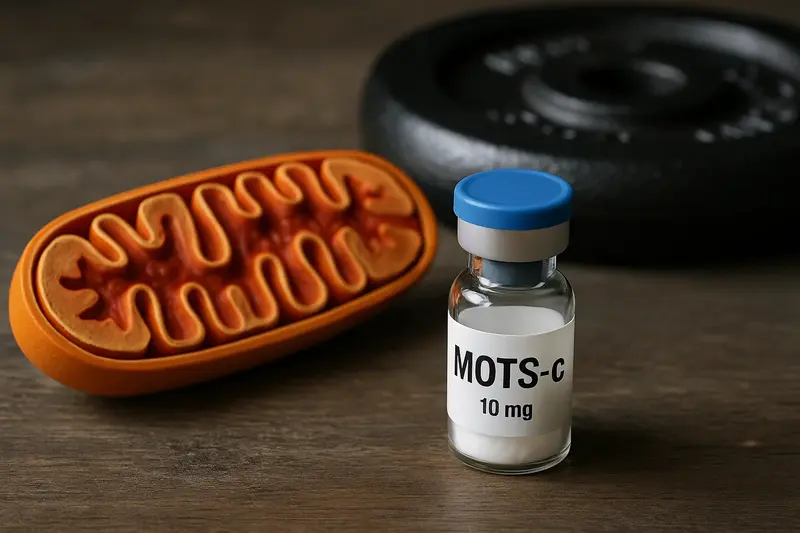MOTS-c and Mitochondrial Health: A New Frontier
Written bySpartan Peptides

Imagine a peptide so intriguing that it’s being whispered about in both anti-aging labs and gym locker rooms. One day you might overhear a fitness enthusiast calling it “exercise in a vial.” That compound is MOTS-c, a tiny protein from an unexpected source – our mitochondria – and it’s rapidly gaining attention in the worlds of fitness, biohacking, and longevity. In this article, we’ll introduce what MOTS-c is, explore how it works to support metabolism and cellular health, review the latest scientific findings (in mice and beyond), and explain why it’s considered a new frontier in peptide science and mitochondrial health. We’ll also touch on why some in the fitness community are excited about MOTS-c (with a responsible dose of skepticism), and how it fits into broader trends in health optimization.
What Is MOTS-c?
MOTS-c is a 16-amino-acid peptide uniquely encoded in the DNA of mitochondria – the “powerhouses” of our cells. Unlike typical proteins that are coded by our nuclear DNA, MOTS-c originates from the mitochondrial genome (specifically the 12S rRNA gene). This makes it part of a newly discovered family of mitochondrial-derived peptides (MDPs) – essentially hormones produced by mitochondria that can signal to the rest of the body. In fact, some researchers dub MOTS-c a “mitokine” or mitochondrial cytokine, highlighting its role as a messenger from the cell’s energy centers.
What does this little mitochondrial peptide do? MOTS-c’s job is to help regulate metabolism and stress responses in our cells. Under normal conditions, it resides in the mitochondria, but when cells are under metabolic stress (like when you’re exercising or fasting), MOTS-c can actually move into the cell nucleus to influence gene activity. By doing so, it helps adjust how cells use fuel and maintain balance. One key pathway MOTS-c targets is AMPK (AMP-activated protein kinase) – often called the cell’s energy master switch. Activating AMPK triggers processes that make cells burn fuel (like fats and sugars) for energy and improves insulin sensitivity. In simple terms, MOTS-c sends a signal that says: “Hey, we need more energy – let’s boost our metabolism and enhance our stress defenses.” This mechanism is thought to underlie many of MOTS-c’s effects on health and performance. Notably, scientists first discovered MOTS-c by screening human cells for factors that improve metabolic regulation, hinting at its natural role in energy balance.
Another remarkable fact about MOTS-c is its connection to exercise. Studies have found that when people exercise, their muscles release more MOTS-c – one report showed nearly a 12-fold increase in muscle MOTS-c levels after a workout. Circulating levels of MOTS-c in the blood also rise during and after exercise. This suggests MOTS-c might be one way exercise “talks” to our body, improving fitness and metabolic health. It’s as if MOTS-c is part of the molecular language of exercise, which is why some have nicknamed it “exercise mimetic” or “exercise in a vial.” Researchers even observed that giving MOTS-c to mice can mimic some exercise benefits – more on that later. The bottom line: MOTS-c is a naturally occurring peptide that helps mitochondria and cells adapt to stress (like exercise) by tweaking metabolism.
How MOTS-c Supports Metabolic Health
One of the biggest reasons MOTS-c has attracted interest is its potential to boost metabolic health – essentially helping the body manage energy better, which is crucial for things like weight control, blood sugar balance, and overall vitality.
MOTS-c’s metabolic benefits

- Improving Insulin Sensitivity and Glucose Utilization: Several studies in mice have shown that MOTS-c makes the body more responsive to insulin (the hormone that helps cells take up glucose). In the very first experiments with MOTS-c, obese mice on a high-fat diet that received this peptide became more insulin-sensitive and had better control of blood sugar than untreated mice. In fact, older mice – whose muscles were naturally more insulin resistant – had their muscle insulin sensitivity restored to youthful levels with MOTS-c treatment. By activating AMPK and other pathways, MOTS-c helps muscle cells absorb and use glucose more effectively. This has big implications: improved insulin sensitivity means lower risk of metabolic issues like type 2 diabetes. It’s no wonder researchers are exploring MOTS-c as a potential therapeutic avenue for insulin resistance and diabetes (though so far these results are from animal models and cell studies).
- Enhancing Fat Oxidation and Weight Management: Another exciting aspect of MOTS-c is its effect on fats in the body. Experiments indicate that MOTS-c can ramp up fat oxidation – essentially burning fat for energy. In mice fed a fattening diet, those given MOTS-c stayed significantly leaner than those that didn’t get it. How? MOTS-c appears to increase energy expenditure (your cells burn more calories) and reduce fat storage. Researchers observed that MOTS-c triggered the “browning” of white adipose tissue. Browning means white fat (the kind that stores energy) starts acting more like brown fat (the kind that generates heat and burns energy). MOTS-c-treated mice showed activation of brown fat and even a conversion of some white fat cells into a more active, calorie-burning state. Moreover, MOTS-c suppresses the genes that create new fat and boosts genes responsible for breaking down fat. The net effect is that the body tends to burn more fat and accumulate less. For example, one study noted that mice given MOTS-c on a high-fat diet had less weight gain and lower body fat than expected, essentially counteracting the usual obesity effects of that diet. This fat-burning angle has made MOTS-c especially interesting to the weight loss research community. It’s important to stress, however, that these findings are in rodents – we don’t yet know how it translates to humans trying to lose weight.
- Reducing Inflammation and Metabolic Stress: Chronic inflammation often goes hand-in-hand with metabolic disorders (like obesity and diabetes). Intriguingly, MOTS-c may have anti-inflammatory effects as part of its metabolic tuning. In obese mice, treatment with MOTS-c led to lower levels of inflammatory cytokines (such as IL-6 and TNF-α) that are typically elevated in obesity and contribute to insulin resistance. There’s also evidence that MOTS-c can modulate stress signaling pathways in cells – for instance, it might interact with the antioxidant response (NRF2 pathway) and reduce oxidative stress in tissues. By dialing down inflammation and oxidative damage, MOTS-c could create a healthier cellular environment for metabolism to run smoothly. This dual action – improving fuel use and quelling harmful inflammation – is a compelling combo for tackling metabolic syndrome, if it holds true in further research.
Taken together, these effects paint MOTS-c as a potentially powerful metabolic modulator. It’s as if MOTS-c helps “re-calibrate” the body’s energy settings: muscles become more efficient at using fuel, fat tissue shifts towards burning rather than storing, and the inflammatory noise that disrupts metabolism is quieted. In animal studies, the result of these changes was improved weight regulation, better blood sugar control, and higher energy expenditure. Scientists are careful to say “MOTS-c treatment in mice suggests…” because we still need clinical trials to confirm efficacy in humans. But the consistency of the animal data has researchers optimistic that MOTS-c or drugs inspired by it might one day be used to combat obesity and metabolic diseases.
MOTS-c, Exercise, and Cellular Aging

Beyond its metabolic perks, MOTS-c is turning out to be relevant to exercise performance and even the aging process. As we hinted earlier, MOTS-c levels naturally rise during exercise – suggesting it helps mediate some benefits of physical activity. Now let’s delve into what that means and how MOTS-c ties into the quest for healthier aging.
A Built-In Exercise Booster
If you’ve ever experienced the surge of energy and improved endurance that comes with getting in shape, molecules like MOTS-c could be part of the reason why. Research has shown that giving MOTS-c to mice can increase their exercise capacity. In a 2021 study, scientists found that short-term MOTS-c treatment significantly improved the running performance of young, middle-aged, and even old mice. The old mice (equivalent to senior citizens in human terms) given MOTS-c were able to run longer and had better strength/endurance metrics compared to untreated old mice. Essentially, MOTS-c made the older mice behave more like they were young again in terms of physical fitness. Even more intriguing, when very elderly mice (near the end of their lifespan) were put on intermittent MOTS-c therapy, they not only stayed fitter but also showed extensions in healthspan – the period of life spent in good health. These findings have led scientists to propose that MOTS-c might be an “exercise mimetic,” mimicking some effects of exercise at the cellular level. It seems to improve muscle tissue’s ability to handle stress and utilize energy, which naturally would translate to better exercise performance.
Aging and Mitochondrial Health
Aging is often accompanied by a decline in mitochondrial function and metabolic flexibility. Interestingly, MOTS-c levels appear to decline with age in both mice and humans. Younger individuals have higher circulating MOTS-c, whereas older adults have lower levels on average. This age-related drop in MOTS-c might contribute to the slower metabolism and increased fatigue we often see in older age. Conversely, maintaining higher MOTS-c activity might help delay some aging effects. Indeed, studies in cells and animals suggest MOTS-c helps activate stress-resistant, longevity-associated pathways. For example, MOTS-c can interact with Nrf2, a protein that turns on antioxidant genes, thereby protecting mitochondria from damage. There’s even a fascinating discovery that certain genetic variants (polymorphisms) in the human MOTS-c gene correlate with longer lifespans in some populations. All this points to MOTS-c as a factor in healthy aging: higher MOTS-c activity = better mitochondrial maintenance = potentially slower aging of cells.
In practical terms, if MOTS-c keeps mitochondria youthful, it could impact age-related conditions. Animal studies have begun exploring this. Aside from the exercise capacity improvements in older mice, researchers have looked at metabolic health in aging models. They found, for instance, that MOTS-c could prevent age-dependent insulin resistance (making the metabolism of an old mouse resemble that of a young mouse). Other preclinical work suggests MOTS-c can protect against age-related bone and cardiovascular issues by reducing oxidative stress and inflammation at the tissue level. It’s important to note these are early findings. Still, the idea of a mitochondrial peptide that helps combat aspects of aging – from muscle endurance to cellular stress – is a tantalizing new frontier.
To sum up, MOTS-c seems to act like a cellular tune-up. It’s naturally pumped out during exercise to enhance performance and resilience, and it might help counteract the metabolic sluggishness that comes with age. As with metabolism, most evidence for MOTS-c’s anti-aging potential comes from lab studies. We don’t yet have a pill that makes people live longer via MOTS-c. But the research race is on – could harnessing MOTS-c one day contribute to longevity interventions? It’s a question scientists find worth pursuing, given the promising data so far.
Why Fitness Enthusiasts Are Turning to MOTS-c
With such intriguing research emerging, it’s no surprise that MOTS-c has caught the eye of fitness enthusiasts and biohackers. In online communities, you’ll find people sharing anecdotes about self-experimentation with MOTS-c peptide injections (often obtained from research supply companies). Their goal? To tap into the benefits seen in labs – fat loss, more energy, better workouts, faster recovery, and even anti-aging effects.
Some bodybuilders and athletes talk about MOTS-c as a way to accelerate fat burning or enhance endurance beyond what training and diet alone can do. It’s being informally compared to an exercise boost in injectable form. In fact, the buzz phrase “exercise in a vial” has been used on social media to describe MOTS-c’s appeal. Imagine doing less cardio but potentially reaping similar metabolic benefits – that’s the kind of hype driving interest in this peptide. On forums like Reddit and in biohacker circles, early adopters have reported anecdotal outcomes such as feeling more sustained energy during workouts, quicker trimming of stubborn fat, and improved stamina. For example, some users claim they feel a noticeable uptick in daily energy and workout performance when using MOTS-c, describing it as if their “mitochondria are firing on all cylinders.” Others mention modest weight loss or better blood sugar readings, though these are personal reports and not scientific trials.
It’s very important to emphasize that these are anecdotes, not clinical evidence. There are also reports of side effects from unsupervised use – things like increased heart rate, insomnia, or injection site irritation in some cases. Because MOTS-c influences metabolic pathways, it’s plausible it could have unintended effects, especially with long-term use, that we don’t fully understand yet. Moreover, regulatory agencies have taken note: MOTS-c is not approved by the FDA for any medical use (it’s not a prescription drug or a dietary supplement legally). In fact, it’s explicitly listed as a banned substance in professional sports – the World Anti-Doping Agency (WADA) prohibits MOTS-c as a metabolic modulator (AMPK activator). This means athletes could get sanctioned for using it in competition. The WADA ban is a double-edged sword in reputation: on one hand it suggests MOTS-c might enhance performance (or they wouldn’t bother banning it), but on the other hand it underscores that using it is against the rules and potentially unsafe or unethical without medical oversight.
So why are fitness folks still intrigued? The allure lies in the peptide’s novel approach. Unlike stimulants or hormones that people have used in the past, MOTS-c operates at a more fundamental cellular level – it’s tweaking the way mitochondria produce energy and how muscles utilize fuel. For biohackers obsessed with optimization, that’s a very compelling mechanism. It also doesn’t hurt that MOTS-c is natural to the body (produced by our cells in small amounts), so some perceive it as safer or more “body-friendly” than synthetic drugs. The rising popularity of peptide therapies in general – ranging from well-known ones like BPC-157 for healing to growth hormone secretagogues for muscle – has created a culture where trying a peptide like MOTS-c feels like the next logical step in self-improvement.
In summary, MOTS-c has become a buzzword in elite fitness and anti-aging circles due to its promising metabolic and endurance-enhancing profile. However, any enthusiastic n=1 experiments should be approached with caution. The peptide is unregulated for human use, and anyone obtaining it is typically buying it under the disclaimer “for research purposes only.” Until more data emerges, the experiences of early users remain interesting but anecdotal. It’s a compelling story – a mitochondria-hacking peptide that might keep you lean and energetic – but we need science to catch up with the hype. As always, if you’re considering exploring peptides, it’s wise to consult a knowledgeable healthcare professional and weigh the risks. The excitement is understandable, but proceed at your own risk and with eyes open.
MOTS-c: A New Frontier in Peptide Science and Mitochondrial Health

MOTS-c sits at the intersection of two major trends in modern health science: the peptide revolution and a renewed focus on mitochondrial health. In recent years, researchers and health enthusiasts alike have been turning their attention to mitochondria – improving the “powerhouses” of cells is now seen as key to boosting metabolism, increasing energy, and even extending lifespan. At the same time, there’s been an explosion of interest in therapeutic peptides (short proteins like MOTS-c, BPC-157, TB-500, and many others) as highly targeted tools to influence bodily functions. MOTS-c happens to encapsulate both trends, being a peptide from the mitochondria that promises widespread benefits.
Broader Scientific Context
Mitochondrial health has become a hot topic in the fight against chronic diseases and aging. You may have heard of strategies like NAD+ supplementation, intermittent fasting, or ketogenic diets – many of these aim to stimulate mitochondrial function and resilience. Now, MOTS-c and related mitochondrial peptides are emerging as direct mitochondria-targeting signals. They represent a new frontier because for decades scientists believed the mitochondrial genome only encoded a handful of proteins involved in energy production. The discovery of MOTS-c (and other MDPs like humanin) revealed that mitochondria also encode regulators that talk to the rest of the cell. This opens up an entirely new layer of biology: mitochondria as endocrine organelles. The implications are profound – we might develop therapies that boost these internal peptides or mimic their effects to improve health in ways not previously possible. As one research paper put it, our aging and metabolism may be regulated by genes in both our nuclei and our mitochondria, working in concert. MOTS-c is one of the first examples of such mitochondrial gene signals being leveraged deliberately.
Future Directions

The excitement around MOTS-c has prompted further research and even some early forays into clinical development. Laboratories worldwide are now studying MOTS-c in the context of obesity, diabetes, muscle wasting, cardiovascular disease, neuroprotection, and longevity. While much of the work is preclinical, it’s rapidly advancing. Notably, a biotech company has developed a MOTS-c analog (a modified version of the peptide) and taken it into Phase 1 clinical trials for non-alcoholic fatty liver disease (NASH) and obesity. This means the first tests in humans are underway to see if a tweaked MOTS-c peptide can reduce liver fat and improve metabolic markers. The results of such trials will be hugely informative – they’ll tell us how MOTS-c-like therapies perform in people, and what kinds of effects or side effects to expect. If successful, we might see more analogs or even the natural peptide itself move toward medical use. It’s worth noting that because MOTS-c is a natural peptide, pharmaceutical interest may revolve around creating patentable analogs with enhanced stability or activity (our bodies might break down MOTS-c quickly, for example). Regardless, the concept that boosting a mitochondrial signal can treat a metabolic disease is groundbreaking. It heralds a shift from simply targeting symptoms (like high blood sugar or appetite) to repairing fundamental metabolic regulators in cells.
Availability and Research Use of MOTS-c
As MOTS-c transitions from lab research to potential therapy, accessibility is a double-edged sword. Right now, MOTS-c is available through research supply companies. For instance, Spartan Peptides offers research-grade MOTS-c for scientists or qualified individuals exploring its effects. In addition, innovative peptide blends are coming to market to capitalize on synergistic effects. Spartan Peptides even provides a combination Skinny & Fit blend that pairs MOTS-c with Semaglutide (a GLP-1 analog known for appetite suppression) and AOD-9604 (a fragment peptide touted for fat-burning) to cover multiple facets of weight management in one stack. The idea is that an appetite-control peptide plus a metabolic booster peptide together might yield comprehensive support for weight loss research.
For those who want to dive deeper into the science behind MOTS-c and other fat-burning peptides, check out our blog article “Top 5 Peptides for Weight Loss (2025 Update)”. It breaks down how different compounds like MOTS-c, Semaglutide, and AOD-9604 may work together to support metabolic health and body composition goals.
MOTS-c represents a new frontier in both peptide science and metabolic research. It highlights the mitochondria not just as energy producers, but as active regulators of how we age, perform, and recover. While the data from animal models is promising — showing improvements in fat metabolism, insulin sensitivity, and exercise performance — we recognize the need for more clinical evidence before wider application.
At Spartan Peptides, we’re committed to advancing responsible peptide research. Our products are labeled for research use only, and we encourage all researchers and health professionals to approach MOTS-c with both curiosity and caution. As this science evolves, we’re excited to be part of the journey — offering high-quality compounds for those on the cutting edge of metabolic health innovation.